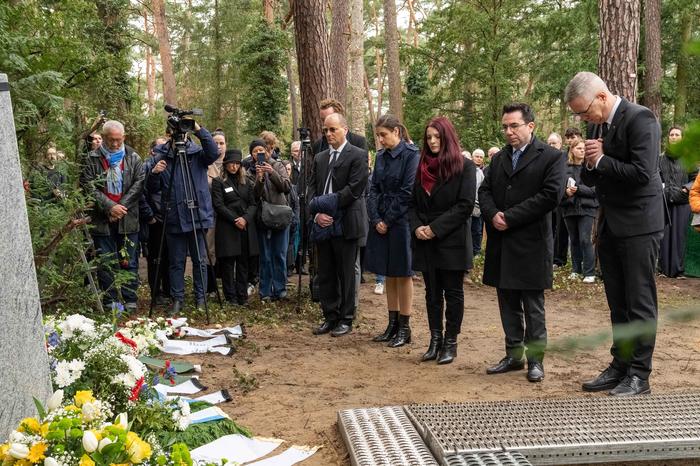Commemorating the Victims of Crimes Committed in the Name of Science
A moment of silence: (from left to right) Israel Kaunatjike, Dr. Christoph Rauhut (obscured), Professor Ulman Lindenberger, Dotschy Reinhardt, Ana-Maria Trăsnea, Daniel Botmann, Professor Günter M. Ziegler.
Image Credit: Michael Fahrig
During construction work and subsequent archaeological investigations conducted from 2014 onward on Freie Universität Berlin premises at Ihnestraße 22 over 16,000 heavily fragmented human bones were excavated.
Analysis work of the site carried out by archaeology professor Susan Pollock and her team showed that the bone fragments came from at least fifty-four different people ranging in age and from males and females. The bone fragments used to be part of collections held by the former Kaiser Wilhelm Institute of Anthropology, Human Heredity, and Eugenics (KWIA). It cannot be ruled out that some of the bones might have originated from a context directly linked to colonial or National Socialist crimes.
The building that now houses parts of the Otto Suhr Institute of Political Science at Freie Universität was home to the KWIA from 1927 to 1945. Through their research on issues related to heredity, the scientists working there were involved in the National Socialist crimes. For example, concentration camp doctor Josef Mengele is known to have sent body parts from murdered inmates of Auschwitz to the institute.
“This is something that we cannot forget. We have a duty to remember them” – Professor Günter M. Ziegler, president of Freie Universität Berlin
The decision to bury the fragments was taken collectively by Freie Universität Berlin, the Max Planck Society (as the successor to the Kaiser Wilhelm Society), the Berlin Heritage Authority, the Central Council of Jews in Germany, the Central Council of German Sinti and Roma, and other groups representing the victims. They agreed that any attempts to assign the human remains to specific groups using invasive measures would essentially reproduce the racist methods and classifications of the past, as Professor Ziegler explained.
The individuals to whom the 16,000 bone fragments belonged were laid to rest in a memorial service that took place at the Waldfriedhof Dahlem cemetery on March 23, 2023. This dignified ceremony was conducted without the use of religious or Eurocentric symbols.
“The memorial that will be placed here should serve as a reminder that we are once again facing antisemitism, racism, antiziganism, and antiromaism today. This place of remembrance should act as a symbol for us all; a reminder that we must remain vigilant! May the individuals we are commemorating today finally be at peace” – Israel Kaunatjike, educational consultant and expert on German colonial history in south-western Africa
Funeral speeches (in German, as given by the speaker)
- Speech by Daniel Botman, Central Council of Jews in Germany
- Speech by Prof. Dr. Ulman Lindenberger, Max Planck Society
- Speech by Israel Kaunatjike, representative of the Herero in Germany
- Speech by Dr. Christoph Rauhut, Berlin Monument Authority
- Speech by Dotschy Reinhardt, Central Council of German Sinti and Roma
- Speech by Prof. Dr. Günter M. Ziegler, Freie Universität Berlin
Further University Articles on the Topic
- February 2024: “A Warning for All of Us, Showing Where Hatred Can Lead”
- January 2024: Crimes Committed in the Name of Science
- May 2023: Possible Remnant of Colonial Injustice
- April 2023: “We Must Remain Vigilant”
- February 2021: “No Closure Yet”
Press Releases on the Topic
- Freie Universität Berlin, Max Planck Society, and the Berlin Heritage Authority: Memorial Service and Burial of Human Remains (March 23, 2023)
- Freie Universität Berlin, Max Planck Society, and the Berlin Heritage Authority Announce March 23, 2023, as Date for the Memorial Service and Burial of Human Remains (February 27, 2023)
- Freie Universität Berlin, Max Planck Society, and the Berlin Heritage Authority Are Planning the Burial of Human Remains Found on Campus (November 17, 2022)
- Freie Universität Strongly Refutes Baseless Allegations by Götz Aly (June 10, 2021)
- No Certainty on Origin of Human Remains Found on Campus (February 23, 2021)
- Public Information Event to Be Hosted by Freie Universität Berlin, Max Planck Society, and Berlin State Monuments Office to Address Human Remains Found on Campus of Freie Universität Berlin (February 05, 2021)
- More Findings on Campus of Freie Universität Uncovered (September 01, 2016, in German)

